Catalogue of remarkable citizen innovations 2020 : 1. Energy
The power of simple ideas that re-enchant the world !
septiembre 2020
Innovation Citoyenne et Développement Durable (ICDD)
On the occasion of the 2020 Produrable Fair, in a difficult context due to a particularly aggressive pandemic, which challenges our lifestyles, our ways of producing and trading, as well as our modes of governance, the ICDD association is pleased to present some thirty innovations or remarkable citizen initiatives that it is currently supporting
Concerning climate issues, or the necessary abandonment of fossil fuels in the short or medium term, it was frequently said in high places that a solution would be found: Each time a major problem was posed, it seemed that a solution was always found, until now.
« Don’t worry: we’re taking care of you and everything is under control: you can come and go as you please. In fact, it has become clear, especially with the arrival of the pesky and elusive Coronavirus, that this is not the case: our world is very fragile, and it doesn’t take much to suddenly stop the frenzy of human activity and confuse the Academies of Science, Medicine and Technology.
Things are becoming more problematic, more complex and more difficult to predict. Faced with the urgency of the situation, faced with the tragedies that are happening and that are occurring more and more frequently, we realise that it is urgent for everyone, and in particular all citizens, to be « on deck » and to see what they can do to participate in the resolution of the problems that collectively face us all.
Citizens have not waited to be asked to do so: they have long been aware of the issues at stake and, here and there, have devised solutions that are particularly relevant:
-
By their originality
-
By their simplicity
-
By their return to a common sense that had often been lost
-
By their concern for economy of means
-
By their sense of solidarity
-
By their formidable efficiency
The « problem » being that « we didn’t ask them anything »! It is therefore very difficult for their solutions to be heard, encouraged and supported, and then, once they have been developed, to be promoted to the extent of their potential impact, which is sometimes considerable.
The field of citizen innovation has never been so vast; it concerns all aspects of common life, all dimensions of the human ecosystem. To carry out our monitoring, we have focused on the priority expectations of citizens in a number of areas.
Energy is a major issue; for the last 150 years most of our energy has been based on fossil fuels. By burning them, we are loading our atmosphere with carbon and directly contributing to global warming.
Several avenues are being explored: reducing energy losses, improving the efficiency of renewable energy production systems, creating new sources of energy that are not yet fully exploited (energy from the sea, hydrogen cells, etc.) and energy storage.
Citizen innovations to help solve the issue of abundant, inexpensive and decarbonised energy are the most numerous; they make up almost a third of this catalogue! We present them here by taking up each of these paths in turn:
Reducing « fatal » energy losses by recovering what we release into the atmosphere ("negawatts" recovery):
This is what Terraotherm (Grande Synthe. Nord) is doing thanks to a very ingenious process inspired by an ancestral device from the East: the hookah! It is so simple, in fact, that the experts found it hard to believe.
However, the French Academy of Technologies, when consulted, validated this process, while confirming its astonishment: it was therefore recognised as Good News from the Territories in 2017! (It is understandable that the academicians who are the bearers of French high technology did not think for a moment of the hookah principle for thermal exchanges!)
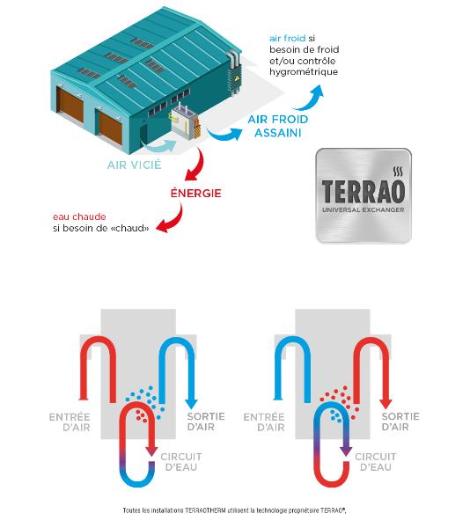
As it passes through the water, the air takes on the temperature of the water and ‘cleans’ itself
Example of application: By recovering the heat dispersed in the air and reinjecting it into the water, this process makes it possible to divide by 2 or 3 the energy consumption of municipal swimming pools and aquatic centres.
This process has a dual effect of saving energy and cleaning the air. This is particularly true for cleaning the air in municipal swimming pools, which contain chlorinated vapours that are harmful to those who live permanently in these facilities (see Fact Sheet 1.1 and terraotherm.com/ ). See also the environmental impact of this same technology, applied to high-temperature industrial fumes with the Terraosave application (Fact Sheet 2.1). Other applications for Terraotherm include the air conditioning and sanitation of agricultural greenhouses, shopping centres, etc.
Making the most of solar energy to enable existing buildings to become energy self-sufficient, not only in Provence, but in the heart of the Vosges where the winters are harsh.
This is what Li-Mithra set out to do: to design an installation that recovers photovoltaic and thermal energy from the sun « at the same time » and to combine it with a heat pump that ensures optimised management to recover as much energy as possible from the system. This Li-Mithra technique (Epinal, Vosges) was recognised in 2019 as « the best current solution for achieving energy autonomy in buildings », quoted in: « La Maison à Energie Zéro » (Eyrolles, 2019).( Fiche 1.2 and www.li-mithra.fr/ )
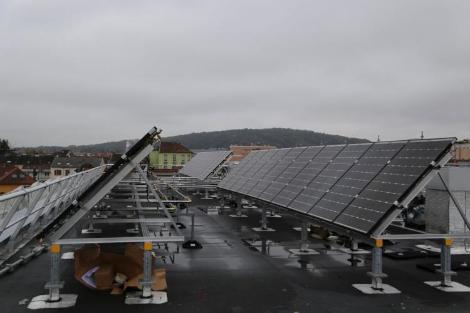
Another application of solar energy recovery is the development of a solar motor that converts solar energy directly into mechanical power, using a motor with a rotor equipped with photovoltaic cells.
Designed and developed by the company Saurea. The particular advantage of this motor is that it is completely autonomous and requires no maintenance.

Current power 130 W; developments are underway for a range from 10 to 200 W. This motor, installed in isolated locations, far from any mains connection, can for example draw water from a well at a depth of 25m and lends itself to multiple applications. see Sheet 1.3 and www.saurea.fr/
This revolutionary engine is being used in Auxerre, and soon in Pradelles, in the Haute-Loire.
Other approaches: Production of new renewable energy, inexpensive, and without the use of rare or sophisticated materials,
-
by judicious recovery of energy from the sea,
-
by recovering energy from green waste,
-
and by a new technology used for hydrogen fuel cells.
Energy from the sea.
It is indeed tempting to recover the energy that can be produced by the waves under the effect of the wind. This has been on the drawing board for a long time, but so far no one has found a satisfactory solution that is both simple and inexpensive. This is what the marine solutions provider HACE (HydroAirConceptEnergy, Bordeaux) is on the verge of achieving with a very simple wave energy recovery system.) A prototype has been tested on a full scale off La Rochelle; it remains to be validated as to its durability over time… and in all weathers. If it holds up, it would be an undeniable breakthrough, with a price per KWh that defies all competition.
See Sheet 1.4 and hacewave.com/
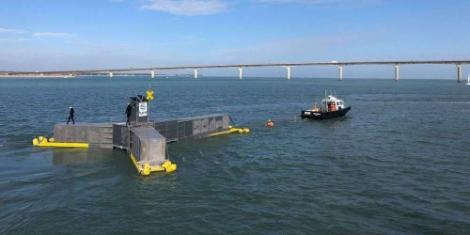
Another approach to « new energy » is to produce it from biomass waste.
According to the Négawatt association, biomass should be able to meet 50% of our energy needs by 2050.
We are familiar with approaches such as methanisation and the use of « wood energy » in the form of pellets, but there is also the staged combustion of green waste proposed by MinigreenPower in Hyères (Var).
Installations of this type are starting up in Brittany (Landivisau), Italy, Great Britain, Madagascar… and in Rwanda as a « Power Station » (photo).

See Sheet 1.5. and www.minigreenpower.com/
This application allows farms to make use of their green waste, in particular to dry their production or to produce additional electrical energy, which is always very useful, especially in farms that are far from any alternative source of energy.
Another future energy process is the compact fuel cell.
Developed by Pragma Industries (Biarritz), it uses a hydrogen tank to generate autonomous, reliable, light and powerful electrical power (range from 200 to 470 W). Lifetime at full output of more than 7 years. Beyond that, it can be used for years at reduced efficiency.
Eco-designed for minimum impact on the environment: materials used can come from recycled material, etc…
Main applications: as a replacement for generators, in humanitarian disasters or to avoid pollution from fossil fuels or electric batteries.
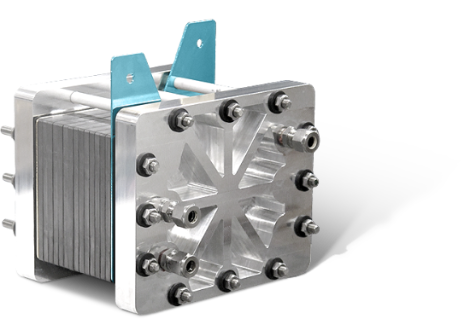
Compact fuel cell. Sheet 1.6, www.pragma-industries.com/fr/
See also in the chapter « transport/mobility » an application of this technology for « hydrogen bikes » - (sheet 5.4 and www.pragma-industries.com/fr/
Energy storage solution.
While energy from sea waves and biomass can be considered « globally permanent » (green waste can always be stored, and the sea is almost always in motion), energy from the sun and wind is « intermittent ». It is therefore necessary to ensure the storage of energy. Battery storage solutions are expensive, and recycling them is a problem, despite efforts to extend their lifespan by two or three times. Three new solutions are emerging:
Hydraulic storage
The solution of hydraulic storage has been known for a long time, but it is expensive to implement, unless the geographical conditions are suitable. This is the work of the Stepsol team, based in Corsica, which has just been selected for an original storage installation for local and isolated needs (a frequent case in the islands).

Hydraulic energy storage in Corsica. Sheet 1. 7. and stepsol-energy.com/
The solar station (bottom) allows water to be brought up to a reservoir (high point). When energy is needed, the water in the reservoir is « turbined ».
Flywheel storage
Here again, the solution has been known for a long time and is sometimes used in mountainous regions for transport: during descents, a heavy flywheel starts to turn and store the vehicle’s potential energy; this energy is then released for a certain time on the plain or during the ascent to move the vehicle forward without the need for any other energy source The company Energiestro (Chateaudun, Eure-et-Loir) has designed and developed a concrete flywheel energy storage system: a pilot plant is planned to produce 10 to 50 kWh units in 2021.
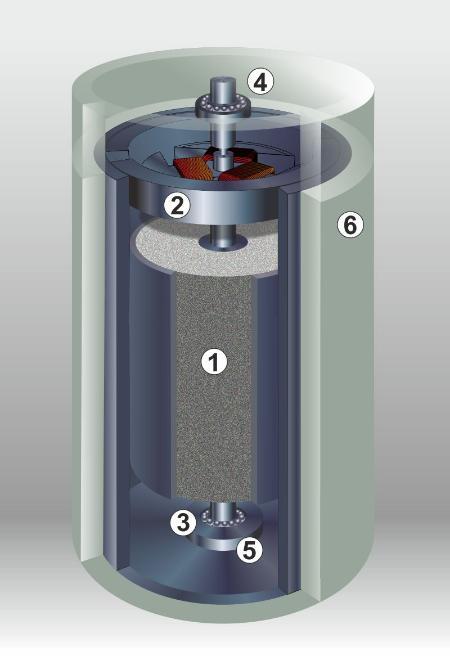
The ENERGIESTRO flywheel consists of a concrete cylinder (1) pre-stressed with a fibreglass winding. It is capable of withstanding a high speed of rotation to store energy in kinetic form. A motor/alternator (2) transfers electrical energy to the flywheel (acceleration) and then recovers it (braking). The lower (3) and upper (4) bearings are ball bearings. A passive magnetic stop (5) supports the weight of the flywheel. A sealed enclosure (6) holds the flywheel in a vacuum to eliminate air friction. An electronic converter (not shown) transforms the DC voltage from the solar panels into a high frequency AC voltage for the motor/alternator.
Sheet 1.8., www.energiestro.fr/
Hydrogen storage
This type of storage, which seemed dangerous and difficult to control, is on the way to becoming THE solution of tomorrow: at least this is an area that is currently advancing rapidly. In addition to the " Compact Fuel Cell " presented above, we will see two concrete illustrations in this catalogue at the level of transport (Businova hydrogen bus, Albi, page 25, and Hydrogen bicycles developed by Pragma Industries, Biarritz, page 27)
Referencias
links to sheets : inks to the sheets see pdf doc attached(pdf/710 – icdd_rpertoire_des_innovations_citoyennes_produrable_200720.pdf)